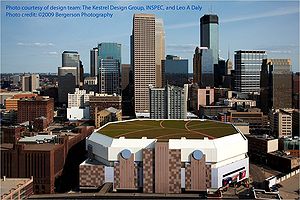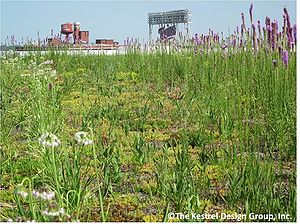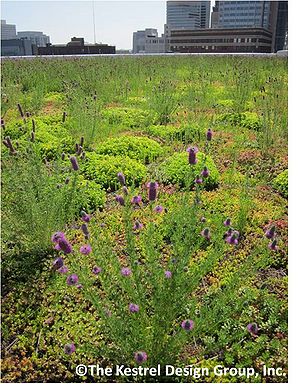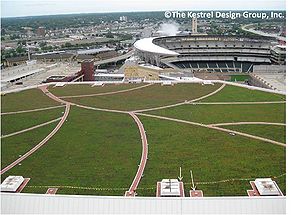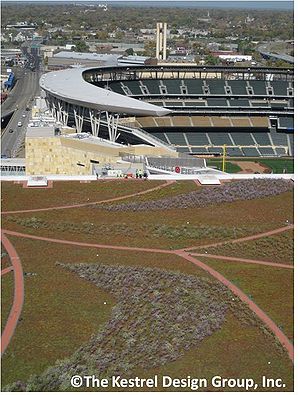
Target Center Arena Green Roof
When Minneapolis’ Target Center Arena needed a new roof, the City of Minneapolis chose to model a sustainable building and stormwater management approach by re-roofing with a green roof. At 113,000 square feet, the Target Center Arena green roof was the fifth largest extensive green roof at the time of design and the first green roof installed on an arena in North America. The green roof mitigates the urban heat island effect, provides greens views from above, provides wildlife habitat, and improves urban air quality on a scale that is not feasible at grade in an ultra-urban area like the site of the Target Center Arena in downtown Minneapolis. It also mitigates stormwater runoff from a significant amount of previously impervious surface in a downtown location where space does not permit use of other Low Impact Development (LID) techniques for stormwater management at grade. Such positive impacts on local water bodies are valuable in a City that prides itself on its legendary waterbodies - The City of Lakes in the Land of 10,000 Lakes.
The design process began with a quantitative and qualitative lifecycle cost benefit analysis that enabled the City of Minneapolis to decide with confidence that replacing the conventional roof on the Target Center with a green roof was the most cost effective and ecologically sound decision over the lifespan of the proposed roof. Quantitative financial lifecycle cost benefit analysis showed that over a 20 year study period, a green roof is more cost effective than a white reflective or a traditional roof.
A state-of-the-art waterproofing membrane was used to withstand constant dampness, high alkalinity, and exposure to plant roots, fungi and bacterial organisms as well as varying hydrostatic pressures. To test for leaks and facilitate pinpointing the exact location of leaks throughout the roof’s lifespan so that the amount of overburden removed can be minimized, an Electro Field Vector Mapping (EFVM) leak detection system was installed.
One of the most difficult challenges at this site was structural. At 17.4 pounds per square foot on most of the roof, the Target Center’s dead load capacity is much lower than that of a typical green roof. The designers aimed to maximize stormwater holding capacity and plant resilience on a roof with very limited structural capacity. Because this is a public, highly visible project, designing an aesthetically captivating roof that succeeds right away was another especially important objective.
Design strategies used to achieve these design objectives include:
- choosing a mat pre-grown at grade to allow plants to establish before facing the harsh conditions on the roof; as well as to maximize plant cover and wind resistance 150 feet up in the air;
- requiring a lightweight growing medium;
- including drip irrigation and a water retention layer to compensate for the minimal soil depth available to hold water;
- maximizing plant diversity and adding native plugs and seed to maximize resilience to climate extremes, diseases, and pests;
- adding bold sweeps of native plant plugs to not only increase resilience and ecological benefits, but also make a bold aesthetic statement; and
- shaping the firebreaks as a metaphorical leaf, river, or basketball, to not only meet functional requirements prescribed by the insurance company, but also add a powerful aesthetic element.
The Target Center green roof consists of a 2.75 inch deep growing zone in the center of the main arena roof structure and a deeper 3.5-inch growing zone around the perimeter where the structural capacity is greater. The pregrown Sedum mat was supplemented with 22 species of plugs and 16 species of seed native to Minnesota’s bedrock bluff prairies, a plant community with harsh growing conditions similar to the growing conditions on the Target Center Green Roof. As of 2012, the green roof’s fourth growing season, a diversity of sedum species, plugs, as well as species germinated from seed were thriving on the roof.
File:Target Center Arena Green Roof 2, Minneapolis, MN.jpg|alt=image of target center green roof, Minneapolis, MN|Target Center Arena Green Roof, Minneapolis, MN, Image Courtesy of The Kestrel Design Group, Inc. File:Target Center Arena Green Roof 3 Minneapolis, MN.jpg|alt=image of target center green roof, Minneapolis, MN|Target Center Arena Green Roof, Minneapolis, MN, Image Courtesy of The Kestrel Design Group, Inc. File:Target Center Arena Green Roof 4, Minneapolis, MN.jpg|alt=image of target center green roof, Minneapolis, MN|Target Center Arena Green Roof, Minneapolis, MN, Image Courtesy of The Kestrel Design Group, Inc. File:Target Center Arena Green Roof 5, Minneapolis, MN.jpg|alt=image of target center green roof, Minneapolis, MN|Target Center Arena Green Roof, Minneapolis, MN, Image Courtesy of The Kestrel Design Group, Inc. </gallery> Target Center Arena Green Roof, Minneapolis, MN, Image Courtesy of The Kestrel Design Group, Inc.
